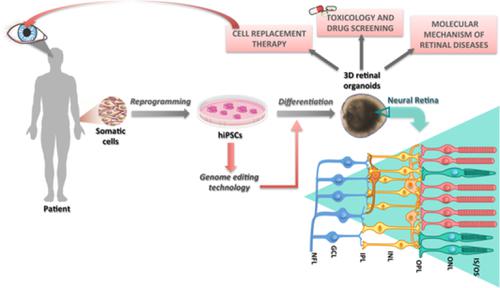当前位置:
X-MOL 学术
›
STEM CELLS
›
论文详情
Our official English website, www.x-mol.net, welcomes your
feedback! (Note: you will need to create a separate account there.)
Deciphering Retinal Diseases through the Generation of Three Dimensional Stem Cell-derived Organoids
STEM CELLS ( IF 4.0 ) Pub Date : 2019-10-31 , DOI: 10.1002/stem.3089 Ana Artero Castro 1 , Francisco Javier Rodríguez Jimenez 1 , Pavla Jendelova 2 , Slaven Erceg 1, 2, 3
STEM CELLS ( IF 4.0 ) Pub Date : 2019-10-31 , DOI: 10.1002/stem.3089 Ana Artero Castro 1 , Francisco Javier Rodríguez Jimenez 1 , Pavla Jendelova 2 , Slaven Erceg 1, 2, 3
Affiliation

|
Three‐dimensional (3D) retinal organoids, in vitro tissue structures derived from self‐organizing cultures of differentiating human embryonic stem cells or induced pluripotent stem cells, could recapitulate some aspects of the cytoarchitectural structure and function of the retina in vivo. 3D retinal organoids display huge potential for the investigation of the pathogenesis of monogenic hereditary eye diseases that are related to the malfunction or degeneration of photoreceptors or retinal ganglion cells by providing an effective in vitro tool with multiple applications. In combination with recent genome editing tools, 3D retinal organoids could also represent a reliable and renewable source of transplantable cells for personalized therapies. In this review, we describe the recent advances in human pluripotent stem cells‐derived retinal organoids, determination of their histoarchitecture, complexity, and maturity. We also discuss their application as a means to decipher the pathogenesis of retinal diseases, as well as the main drawbacks and challenges. Stem Cells 2019;37:1496–1504
中文翻译:

通过生成三维干细胞衍生的类器官来破译视网膜疾病
三维(3D)视网膜类器官,源自分化的人类胚胎干细胞或诱导多能干细胞的自组织培养物的体外组织结构,可以概括体内视网膜的细胞结构结构和功能的某些方面。3D 视网膜类器官通过提供具有多种应用的有效体外工具,在研究与光感受器或视网膜神经节细胞功能障碍或退化相关的单基因遗传性眼病的发病机制方面具有巨大潜力。结合最近的基因组编辑工具,3D 视网膜类器官还可以代表一种可靠且可再生的可移植细胞来源,用于个性化治疗。在这篇综述中,我们描述了人类多能干细胞衍生的视网膜类器官的最新进展,确定其组织结构、复杂性和成熟度。我们还讨论了它们作为破译视网膜疾病发病机制的手段的应用,以及主要的缺点和挑战。干细胞 2019;37:1496–1504
更新日期:2019-10-31
中文翻译:

通过生成三维干细胞衍生的类器官来破译视网膜疾病
三维(3D)视网膜类器官,源自分化的人类胚胎干细胞或诱导多能干细胞的自组织培养物的体外组织结构,可以概括体内视网膜的细胞结构结构和功能的某些方面。3D 视网膜类器官通过提供具有多种应用的有效体外工具,在研究与光感受器或视网膜神经节细胞功能障碍或退化相关的单基因遗传性眼病的发病机制方面具有巨大潜力。结合最近的基因组编辑工具,3D 视网膜类器官还可以代表一种可靠且可再生的可移植细胞来源,用于个性化治疗。在这篇综述中,我们描述了人类多能干细胞衍生的视网膜类器官的最新进展,确定其组织结构、复杂性和成熟度。我们还讨论了它们作为破译视网膜疾病发病机制的手段的应用,以及主要的缺点和挑战。干细胞 2019;37:1496–1504











































 京公网安备 11010802027423号
京公网安备 11010802027423号